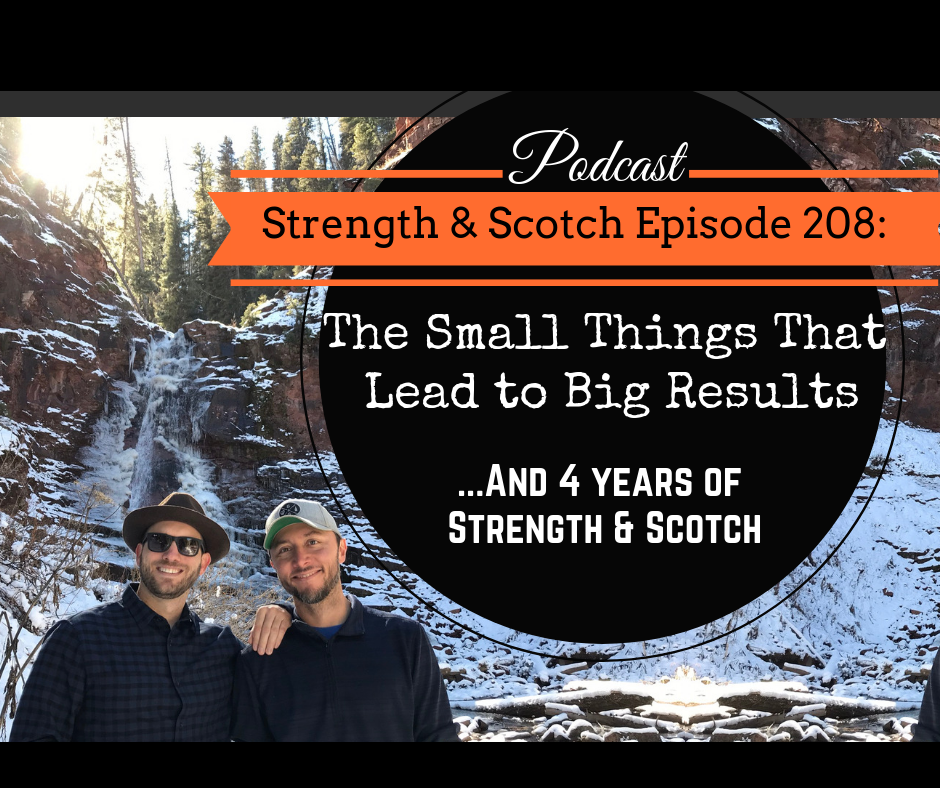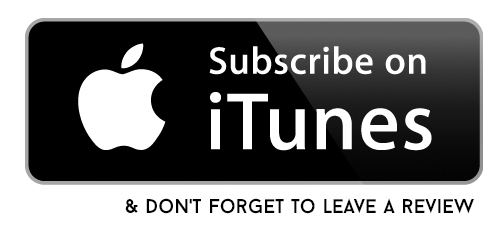SS 208 – The Small Things That Lead to Big Results
Episode 208 Show Notes
For the 4th year celebration of Strength & Scotch, Grant and Heavey take on listeners’ questions. Nate is asking for steps to help people get on track to a healthier lifestyle. First of all, Heavey doesn’t want to outline things you need to do because if, for some reason, you’re not able to fulfill all of them, you may just get frustrated and give up.
Instead, what Grant and Heavey really want people to do is to refer back to the Five Pillars of Health to stay on track. Today, they’ll be walking you through those pillars again. Now it’s up to you to decide on which you think is something you can stick to.
It’s a “choose your own adventure” so to speak. Ready? Let’s begin!
[06:10] The Five Pillars of Health
Right from the start, Heavey wanted to do this show primarily to cut through the BS and get rid of sensationalizing headlines, and instead, talk about what really matters. Hence, Heavey distilled these things into these five pillars:
1. Sleep
2. Stress Management
3. Nutrition
4. Fitness/Activity
5. Human Connection
[07:40] Pillar #1: Sleep
When your sleep is interrupted, you’re not going to feel rested. There are numerous reasons to prioritize sleep. In fact, this is the number one thing that many people should prioritize.
Studies suggest that even one day of poor sleep when normally having a good sleep routine, could lead to impaired glucose response.
Ideally, we should get 8 hours of sleep every night. Heavey gets 9 on average, but any improvement of sleep is very valuable. If you’re falling short of your sleeping hours, find ways to increase your current sleep with something manageable. For instance, if you’re currently sleeping for 6 hours, try to get 6.5 hours. The quantity of sleep is important. Sleeping an extra half hour is even more important than exercising for an extra half hour.
Moreover, say if you have a baby and your sleep inevitably gets interrupted at night, napping may be your only approach to getting more sleep.
Hence, number one baby step is to see how much you’re sleeping right now and figure out how you can prioritize this in your life right now.
[12:20] Quality of Sleep
Grant’s problem is that he sleeps for long hours but still doesn’t feel well-rested. The problem most people have is we’re running all day until we go to bed and this affects our ability to get quality sleep. Activities like watching TV or using your phone can affect the quality of your sleep as well.
The key here is sleep hygiene, which means try to eliminate things like electronics and exercise that are going to rev you up before bed. This depends on each person, but figure out what seems to keep you fussing around at night.
Grant points out how difficult this is for people who are farther on the east coast because of sports, who stay up late at night to see their favorite games. The sports game can put them on an emotional rollercoaster!
[15:05] Ways to Help You Fall Asleep
Interestingly, there are podcasts that help you sleep like reading boring books. The idea behind this is if you listen to these, it puts you to sleep because it gets you out of your head. A lot of times, people have trouble falling asleep because their mind is racing about different things going on in their busy lives.
Music can help put people to sleep as well, although for some people, this could be stimulating. For others, white noise could also help them fall asleep. Find what works for you. Lifehacker recently released an article about the top podcasts to help you go to sleep so check it out.
To sum up our baby steps on sleep, again, try to prioritize increasing your sleeping hours if you’re not getting enough and pay close attention to sleep hygiene.
[18:33] Pillar #2: Stress Management
This pillar is to minimize stressful situations. The Apple Watch has a new app Breathe that allows you to take just a minute to breathe. This could work. Generally, meditation is the standard method for coping with stress. However, this is difficult for many people to do. They struggle with it. Many people can try it for a day or a week, but a lot give up because they fail to see value in it. However, Heavey believes it isn’t the only approach.
One simple baby step you can do is to take 10 breaths on the hour. This can be just as powerful if this gives value to you. Grant adds that with meditation, there’s baggage that comes with the word or idea; whereas with breathing, it’s just the simple act of stopping to breathe for a minute.
[20:44] Get a Device and Gamify Your Experience
Seriously, getting a device like an app watch will push you to do all these little things. These are little baby steps that are so small that you don’t have to change your life but it will be on your wrist that would keep reminding you.
Ultimately, whether that’s meditation, breathing, walking, or whatever it is, do something just to detach yourself from the stresses of your life. Again, find what works for you.
[23:40] Exercise to Cope with Stress and Ways to Eliminate Stress
Some people say that intense physical activity is their stress coping mechanism but Heavey finds this a bit dicey. He’s not really a big fan of it. Grant adds that exercise creates a stressful environment for your body.
Heavey stresses that it’s not just about coping with stress, but you as a human, have an opportunity to curate, to some degree, the amount of stress that’s in your life. If there are things in your life that are stressful, eliminate them. If somebody is bringing you down, then eliminate that person.
[26:32] Another Final Word on Exercise and Stress
Heavey points out that things like exercise that your body can find helpful could also find it harmful if it’s not able to adapt to that stress because exercise is a stress in and of itself. Finding ways to cope with stress and manage stress in your life can help you benefit from these healthy stressors.
[27:08] Pillar #3: Physical Activity
Fitness trackers like Fitbit can be helpful for a lot of people because using it motivates them. But having to hit 10,000 steps a day can be demotivating for a lot of people. If you’re using a fitness tracker, find out what your baseline steps are and just bump it up a little bit. Try to increase that slightly, working on that week to week, month to month to help increase your activity level.
The easiest way is to incorporate any physical activity into whatever you’re doing like taking your baby out for a walk or running on the treadmill while making phone calls. Figure out how you can multitask because exercise can be just as simple as moving your legs.
[31:10] Weight Training Correlates with Longevity
Moreover, you can also mix cardio training and weight training. When it comes to mortality and longevity rates, weight training, where you build muscle strength and size, is what’s so strongly correlated with longevity. Heavey believes everyone should be paying attention to this.
[32:33] Pillar #3: Nutrition
This is another tough one to baby step. Another listener is asking about alternative ways to achieve fat loss through diet besides counting calories and macros, which this person tried for 6 months. He found the physical results to be great but it was too much mentally. For him, it meant spending three hours a day thinking about what to eat. This person eventually stopped and gained weight.
A lot of times when it comes to nutrition, people will default to doing something extreme like eating only 1200 calories a day or eating no carbs or tracking every single food they eat. True, people can achieve incredible results, but they don’t last. And when it doesn’t last, there’s no value to it.
The key here is to find a sustainable approach. Understand the constraints in your life and figure out how to map out some principles so you can come up with a system that works for you – something that is sustainable because that’s where real change happens.
[35:05] Prioritize Protein and Fiber
Fill the majority of your plate with protein and fiber. This will significantly reduce the amounts of calories being consumed, and also, get the necessary nutrients we need to keep healthy. Snacks can be difficult for people too so instead of eating loads of carbs, prioritize protein and fiber.
[38:25] Pillar #5: Human Connection
Heavey thinks this is the thing that has made Crossfit so popular because it has taken fitness, which is something a lot of people didn’t want to do and added a community component to it. Now, they’re surrounded by other people that are prioritizing fitness and are having a good time. Hence, they’re surrounded by a supportive environment.
If you surround yourself with people that support your goals, it’s going to be much easier for you to stay consistent.
[40:25] How Do You Find Time to Make Those Connections?
Find a way to schedule time with your family or your other half – take a walk with your wife or make dinner together – anything you can do to make that connection. Remember why these people are important to you. If you’re struggling with relationships and you think you don’t have anyone, get on the internet. Find somebody you can vibe with.
Find a hobby. Go to a small gym where everybody probably knows everybody so you can get that sense of community.
If you walk through a hospice care, you would be reminded of that possible outcome and how important it is to take care of yourself right now. You may feel like you don’t have time, but you’re not making a priority for those things.
[44:30] Go Back to the Basics
Ultimately, the goal of this podcast is to help people prioritize the things that need to be prioritized. This world could be so clouded with so much BS when really, you just go back to the basics. It’s that passion for helping others, to help people live good, healthy life. So cheers to FOUR amazing years!
Links:
top podcasts to help you go to sleep from Lifehacker

Check out the gear page for everything Strength & Scotch! You’ll find a listing of all the supplements and other programs we’ve discussed on the show as well as our killer t-shirts!

